Sunday, April 25, 2010My, What a Big Head You Have!
Once again instead of bombarding you with all of our photos, here are the top 50!
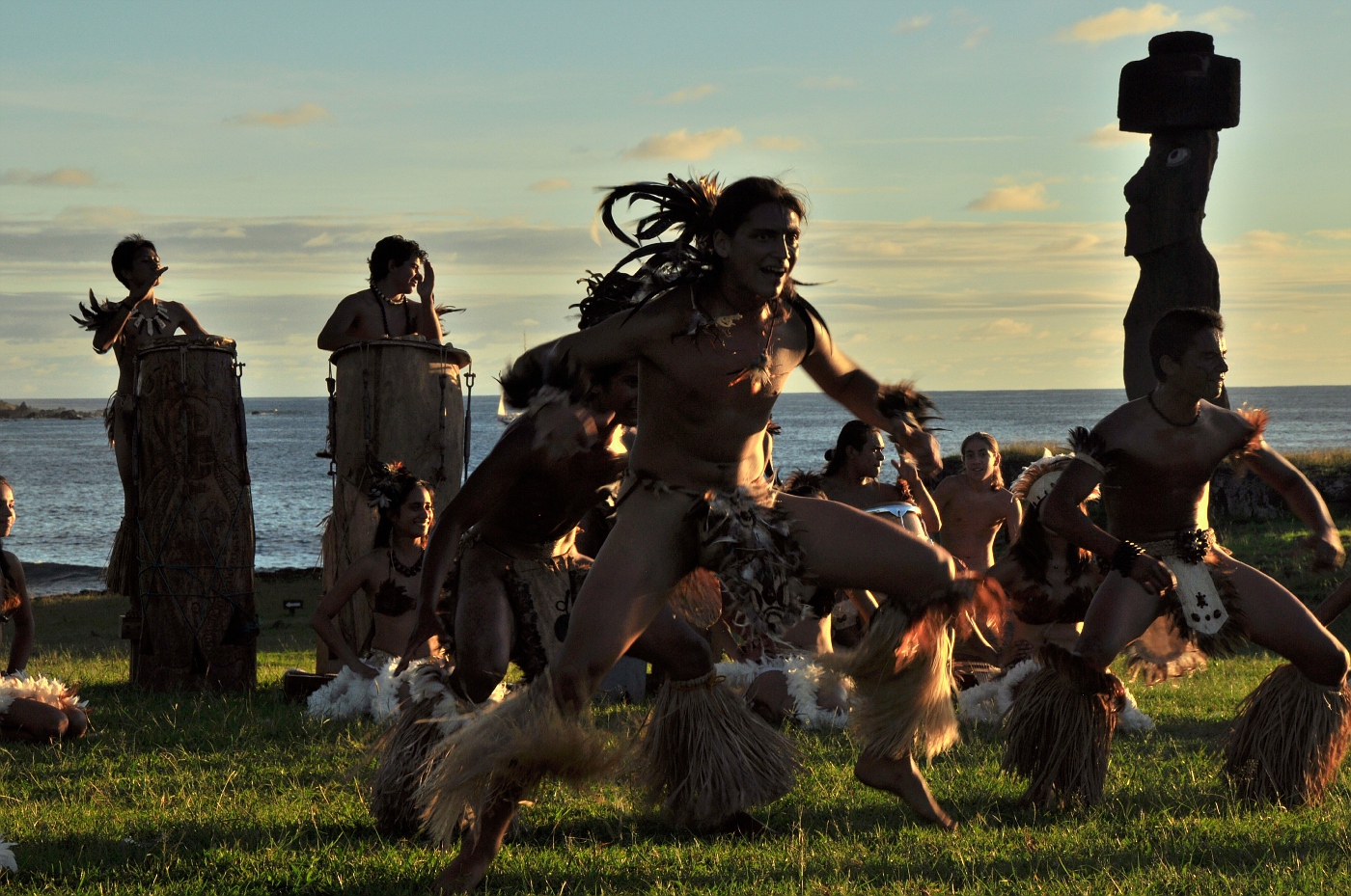 There is one thing that I have learned about me and Troy in the past 5 years: There is no destination too far, too remote, too weird, too scary that we won’t travel to. Ok, obviously Afghanistan won’t be on that list, but you get the idea. Easter Island has always intrigued me and since there is no easy way to get there I decided to tag it onto the end of our Machu Picchu trip. Easter Island is one of the world’s most isolated inhabited island and lies 2000 miles off the west coast of Chili and over 2500 miles east of Tahiti. It is roughly 14 miles by 7 miles with a population of about 3500. What the island is famous for is the moai statues which number around 900! There is one thing that I have learned about me and Troy in the past 5 years: There is no destination too far, too remote, too weird, too scary that we won’t travel to. Ok, obviously Afghanistan won’t be on that list, but you get the idea. Easter Island has always intrigued me and since there is no easy way to get there I decided to tag it onto the end of our Machu Picchu trip. Easter Island is one of the world’s most isolated inhabited island and lies 2000 miles off the west coast of Chili and over 2500 miles east of Tahiti. It is roughly 14 miles by 7 miles with a population of about 3500. What the island is famous for is the moai statues which number around 900!I have pretty much become a travel snob and assume everyone knows as much about travel as I do. So when I get questions about Easter Island such as “Do you take a boat there? Do you just fly over it? Can you go on the island? What’s there? Do cannibals live there?” I have to stop and tell myself “Shelly, no one is as smart as you and knows as much as you! People are also not as pretty and sophisticated as you so give them a break!” Ok, back to the real world… anyways I have to remember that Easter Island is not on every ones radar and when I do run into the occasional person who knows about it (which is rare), I am pleasantly surprised! 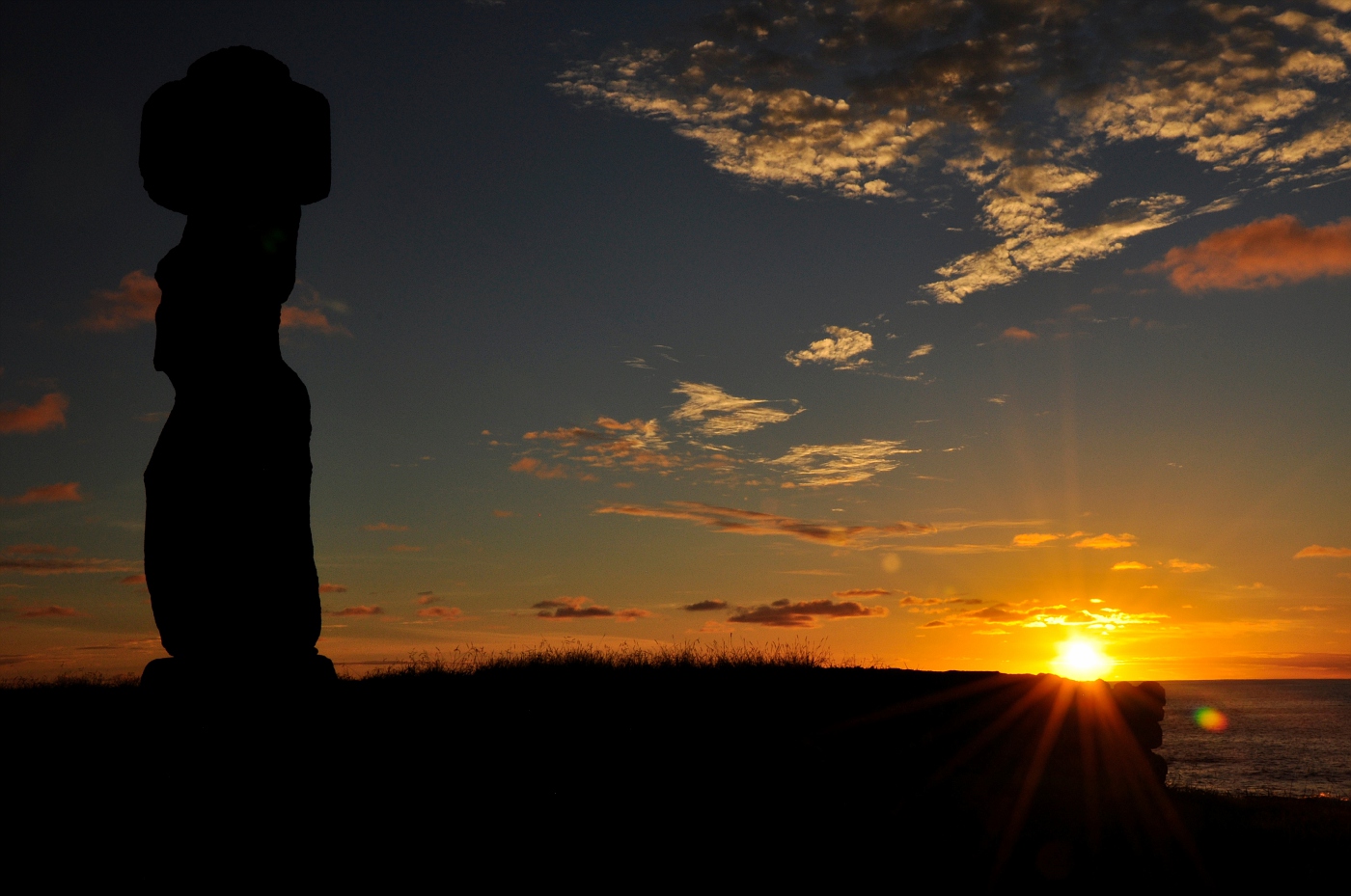 A little background on Easter Island: A little background on Easter Island:
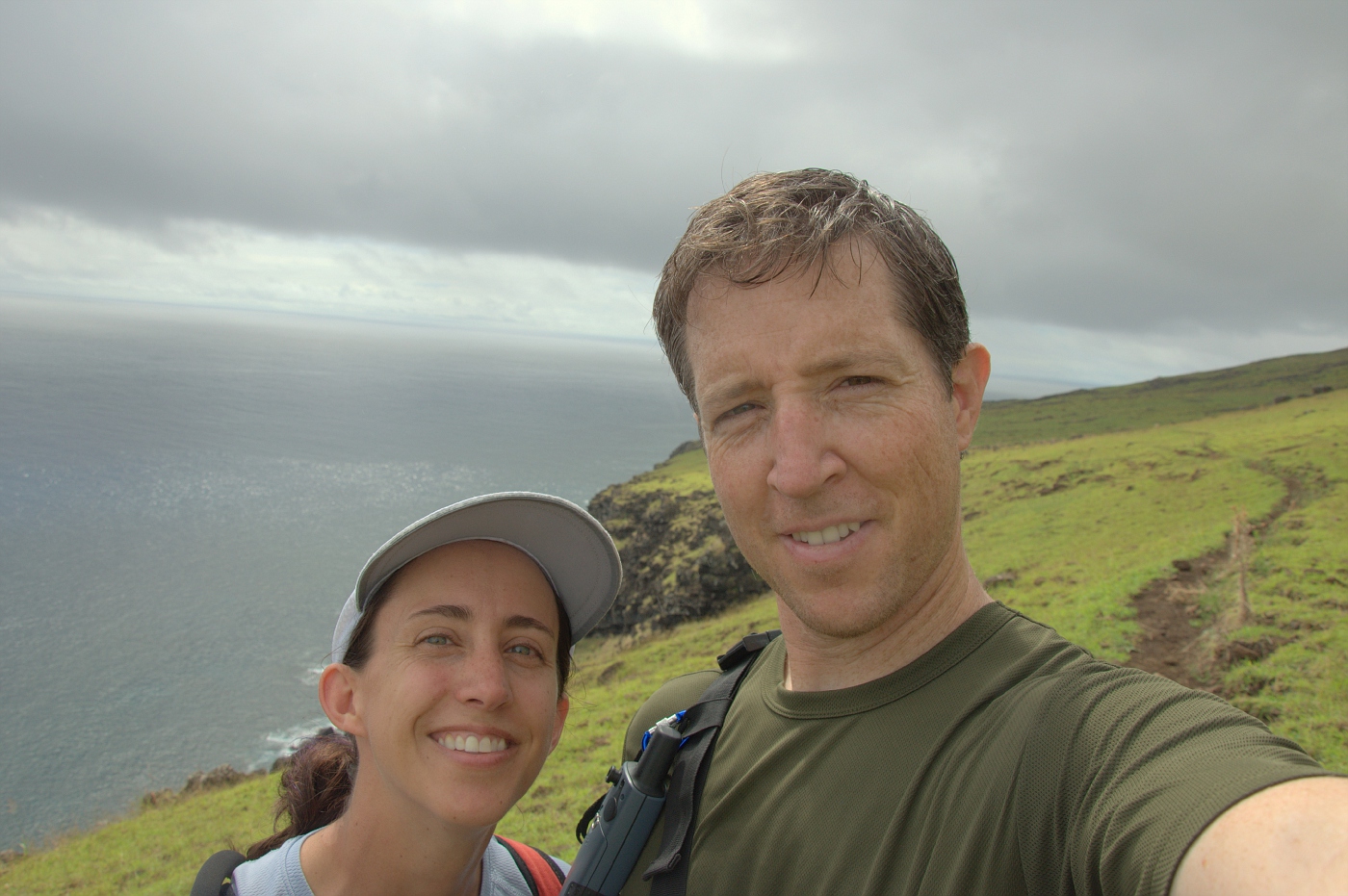 Our first full day on the island was spent on a 13 mile hike around the island. (I guess we didn’t get enough hiking in Peru.) From town we took a taxi to Anakena beach and set out around the northwest coast of the island. Other than seeing 1 car, 2 swimmers, 2 motorcycles and 1 horseman, we saw no one for hours! There were no roads, cars, power lines, people, boats, airplanes…nothing. The only thing we came across were horses, cows and the occasional horse carcass. It gave us a feeling of being very isolated and even abandoned. As we gazed out north from the island towards the open ocean it was scary to think that if we fell in the water and were caught in a northbound current, the next land fall we would make would be, oh, I don’t know, Alaska, or maybe Russia! Or if we’re really unlucky maybe we would just shoot straight past them through the Bering Strait! Ok, I’m exaggerating, we would probably hit the Canadian coast first! Since it is a very volcanic island we were constantly stumbling over small lava rocks that threatened to trip us up at any moment. But the views and the surrounding island was amazing! It's been written that it is one of the finest coastal walks in the South Pacific and I couldn't agree more! Our first full day on the island was spent on a 13 mile hike around the island. (I guess we didn’t get enough hiking in Peru.) From town we took a taxi to Anakena beach and set out around the northwest coast of the island. Other than seeing 1 car, 2 swimmers, 2 motorcycles and 1 horseman, we saw no one for hours! There were no roads, cars, power lines, people, boats, airplanes…nothing. The only thing we came across were horses, cows and the occasional horse carcass. It gave us a feeling of being very isolated and even abandoned. As we gazed out north from the island towards the open ocean it was scary to think that if we fell in the water and were caught in a northbound current, the next land fall we would make would be, oh, I don’t know, Alaska, or maybe Russia! Or if we’re really unlucky maybe we would just shoot straight past them through the Bering Strait! Ok, I’m exaggerating, we would probably hit the Canadian coast first! Since it is a very volcanic island we were constantly stumbling over small lava rocks that threatened to trip us up at any moment. But the views and the surrounding island was amazing! It's been written that it is one of the finest coastal walks in the South Pacific and I couldn't agree more!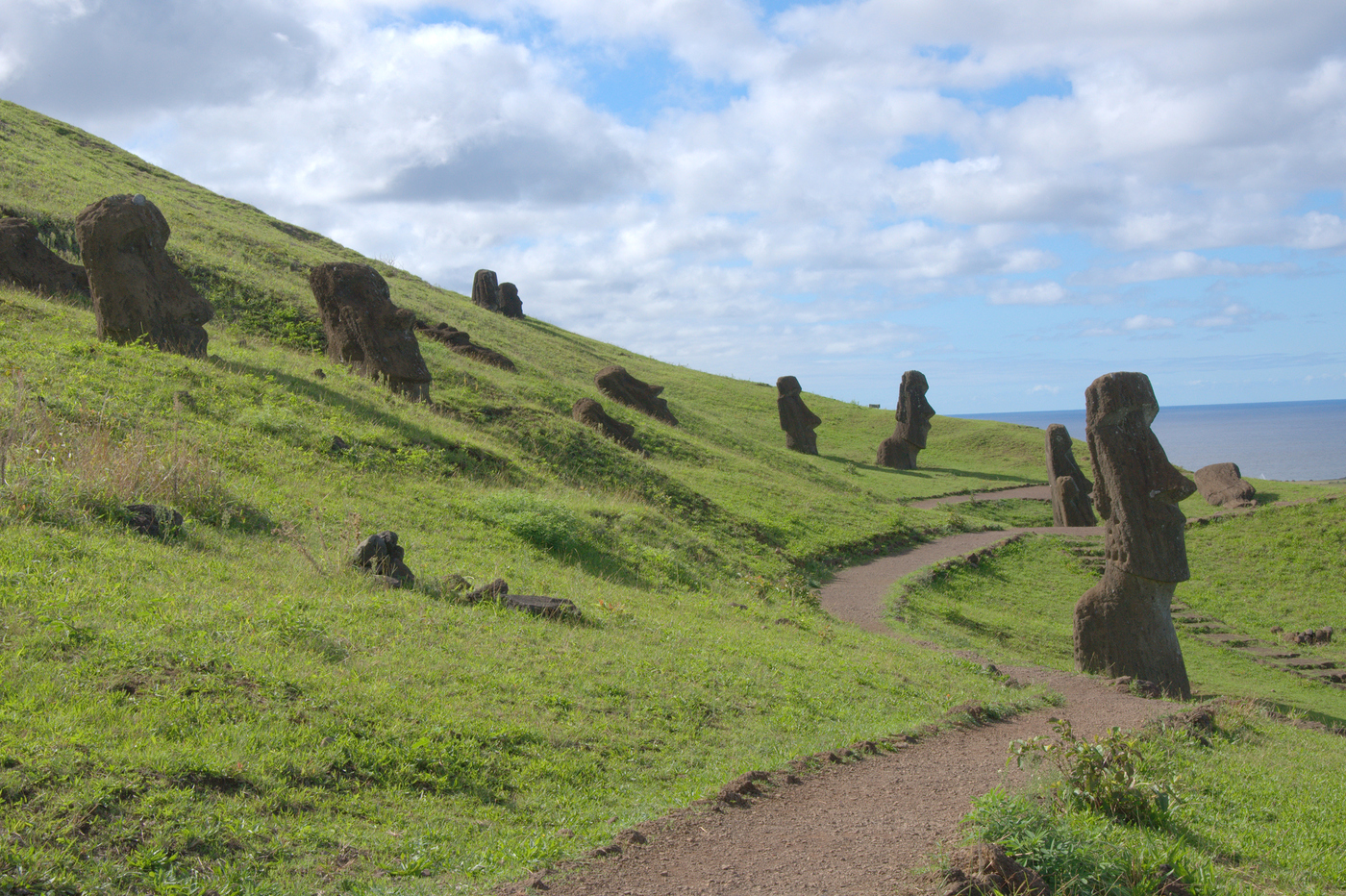 The next day we rented a car and headed out to see the sights. But first we needed to exchange our money since we couldn’t do it at the Santiago airport because it was closed. Pat, our B&B owner, told us to go to the gas station to do this. What? Seriously? The gas station? Ok. Sure enough, the guy pulled out a huge bag of Chilean Pesos and exchanged our USD for local currency at the best exchange rate on the island or Chile mainland. The next day we rented a car and headed out to see the sights. But first we needed to exchange our money since we couldn’t do it at the Santiago airport because it was closed. Pat, our B&B owner, told us to go to the gas station to do this. What? Seriously? The gas station? Ok. Sure enough, the guy pulled out a huge bag of Chilean Pesos and exchanged our USD for local currency at the best exchange rate on the island or Chile mainland.We had no plan for the day so we first headed to Rano Raraku which is the quarry where all the moai were carved. I love having no idea what to expect because it makes the surprise so much better! As you can guess, I had no idea what to expect at Rano Raraku and was shocked when from a distance we could see all these heads sticking out of the ground. (Any minute now there is going to be a “That’s what she said!” opportunity!) In fact the quarry has almost 400 statues in various stages of completion lying scattered around the crater. We parked, paid our admission fee, looked around and realized we were the only ones there! From the side of the hill we could see for miles and there were no cars coming at all! So here is an incredible UNESCO World Heritage site…and me and Troy!  We were able to get all the photos we wanted without any other tourists in the shots! We did make sure to obey the rules and not go off the trail or touch any of the moai or step on the Ahu (platforms). There is one picture that looks like I’m touching the statue, but I’m not. I do have a few caring cells in my body! We found out a few days later that when the big tour groups show up, a ranger follows them around. If someone breaks the rule, the ranger doesn’t reprimand them there, he takes a photo of them. The photos then get hung up at the airport and upon your departure, if your photo is hung up, you get fined! We were able to get all the photos we wanted without any other tourists in the shots! We did make sure to obey the rules and not go off the trail or touch any of the moai or step on the Ahu (platforms). There is one picture that looks like I’m touching the statue, but I’m not. I do have a few caring cells in my body! We found out a few days later that when the big tour groups show up, a ranger follows them around. If someone breaks the rule, the ranger doesn’t reprimand them there, he takes a photo of them. The photos then get hung up at the airport and upon your departure, if your photo is hung up, you get fined!Before we left the quarry, Troy wanted to go inside the crater. I wasn’t interested because… well I wasn’t interested. But I followed him anyways and was glad I did. Inside the crater were about 30 more heads! And again, just me and Troy! 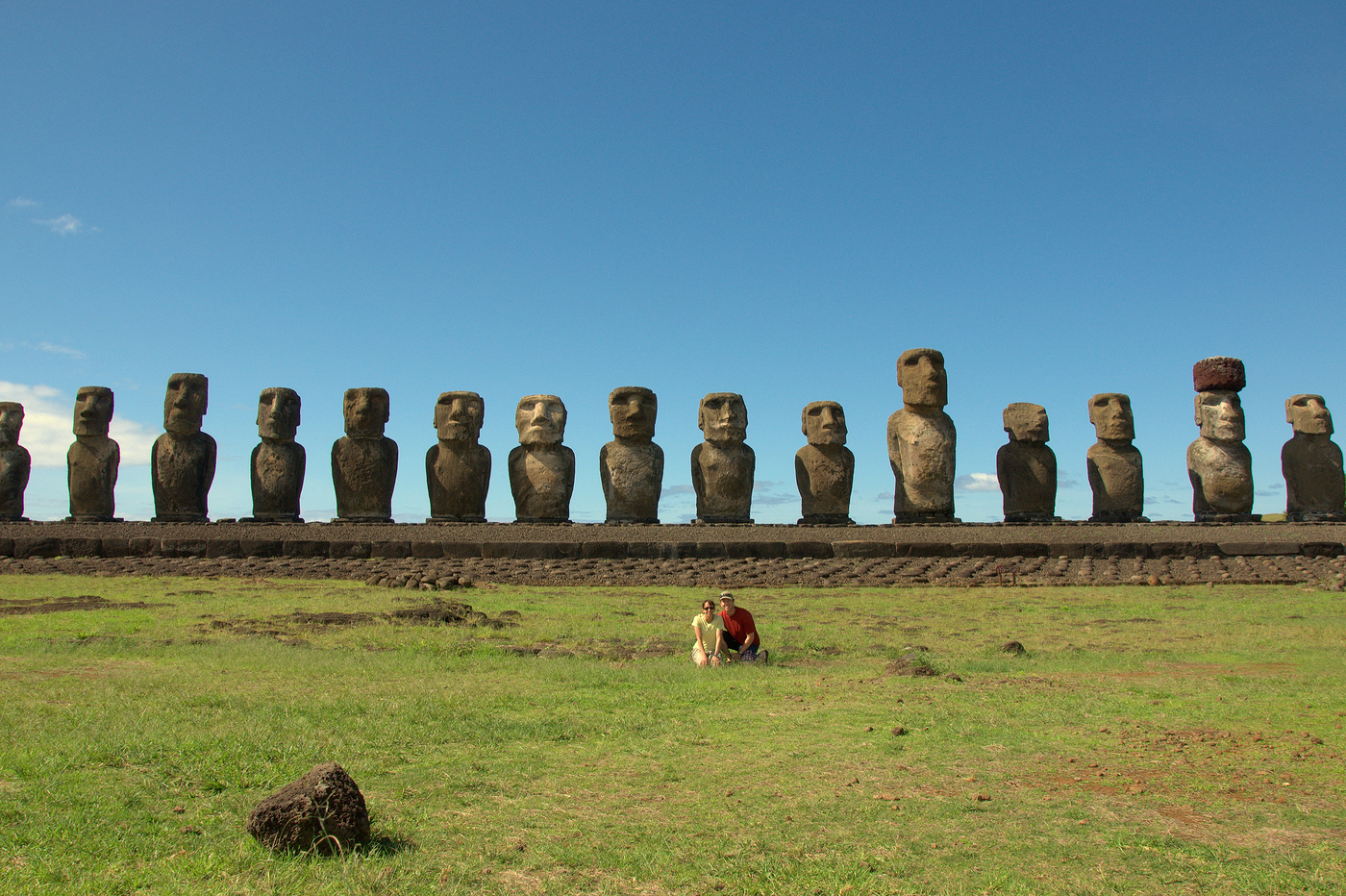 Our next stop was Tongariki which is the most famous sight because it consists of 15 standing moai with a stunning ocean view at their backs. When we got there, there were two tourists and their guide. They left shortly and once again it was me and Troy. We couldn’t figure out where all the tourists were but found out later that week we did the “tour itinerary” backwards. The tour groups leave Rono Raraku and Tongariki as the last stops. Our next stop was Tongariki which is the most famous sight because it consists of 15 standing moai with a stunning ocean view at their backs. When we got there, there were two tourists and their guide. They left shortly and once again it was me and Troy. We couldn’t figure out where all the tourists were but found out later that week we did the “tour itinerary” backwards. The tour groups leave Rono Raraku and Tongariki as the last stops.We went back to Anakena beach for lunch before heading onwards. There was a tiny little shack open for business ran by an old woman. Her menu consisted of four items written on a piece of cardboard. We ordered the tuna and were shooed off while she started her BBQ. When we came back there were four huge pieces of tuna on the grill and I looked around thinking “Who else is she feeding here?” Before I knew it there was a huge plate of food placed in front of my face that looked like it belonged in a four star restaurant! Although I don’t think four star restaurants have enormous amounts of flies that appear out of nowhere. While we’re eating two craft ladies showed up and started to set up their booths. Our BBQ lady started telling them a story and even though we couldn’t tell what they were saying we could tell it was extraordinarily sad. We found out our BBQ ladies 2 year old granddaughter had been killed the day before. She had been accidentally ran over by her father!  We stopped at several other sights on the way back to town but none held our interest the way the quarry and Tongariki did. We visited Akivi which has 7 moai that were erected in the middle of the island and there is much speculation as to why they were built inland whereas all the rest of the moai were placed right along the islands coast. We also stopped to see the quarry where the red hats were made. I would love to know the theory behind why the moai needed hats! We stopped at several other sights on the way back to town but none held our interest the way the quarry and Tongariki did. We visited Akivi which has 7 moai that were erected in the middle of the island and there is much speculation as to why they were built inland whereas all the rest of the moai were placed right along the islands coast. We also stopped to see the quarry where the red hats were made. I would love to know the theory behind why the moai needed hats!The next day we went diving. We knew not to expect much but we can’t go to an island and not dive. Our dive guide was an interesting guy. His name was Henri, was French, over 60 years old and had worked closely with Jacques Cousteau on his boat the Calypso. We wish we spoke French because he would have been a very interesting person to get to know. The diving was ok. Not much fish life, visibility ok, underwater terrain very cool… but at least it was cold! On our second dive I looked at my watch and was excited to see that the dive was almost over because I was very, very cold. At this point Henri looked at everyones' air gauge and continued on. A few minutes later I looked up and thought “Woohoo, there’s the boat! Wait, where you going Henri, the boat is right above us. We’re not stopping? We’re still going? Crap!” Like I said, Henri was interesting but our boat driver was a big fat grump! He looked like the most miserable person on the island! As we’re hanging out at the shop after the dive we notice the little girls funeral procession going through town. The bad thing about our B&B, it’s located right next to the cemetery. As we made our way back to our room, we walked fast, kept our heads down and walked on the opposite side of the dirt parking lot because we didn’t want the locals thinking we were being nosy tourists. The last thing we wanted to do was intrude on this very tragic personal time. One of the sad things about this funeral is that instead of the coffin being taken to the cemetery in a hearse, it was taken in the back of a beat up old Toyota pick up truck.  Our last day we still had not had enough of hiking as we proceeded to do a 9 mile round trip hike to the Rano Kau volcano. The dogs in this town know who the tourists are because as we walked down the street, a random dog would start to follow us. If we stopped in a store or restaurant, he would sit and wait outside until we were done. So as we headed out of town to the volcano, a dog , who we nicknamed Yellow Belly, started following us. We thought after 10 minutes he would get bored and would turn around. No, he followed us the whole way up and back down. I don't think he was used to walking that far because he started to lag as we got to the stop of the volcano. We gave him some water and cheese and then he was good to go. No wonder they follow the tourists. They know we're suckers and will fall for the "I'm so tired!" act! Our last day we still had not had enough of hiking as we proceeded to do a 9 mile round trip hike to the Rano Kau volcano. The dogs in this town know who the tourists are because as we walked down the street, a random dog would start to follow us. If we stopped in a store or restaurant, he would sit and wait outside until we were done. So as we headed out of town to the volcano, a dog , who we nicknamed Yellow Belly, started following us. We thought after 10 minutes he would get bored and would turn around. No, he followed us the whole way up and back down. I don't think he was used to walking that far because he started to lag as we got to the stop of the volcano. We gave him some water and cheese and then he was good to go. No wonder they follow the tourists. They know we're suckers and will fall for the "I'm so tired!" act!I don't think Easter Island will ever make it on any of the Food Networks shows because it is not necessarily known for their food but do they make a killer ceviche. We ate so much tuna! Every day we either had tuna sashimi, tuna steaks or tuna ceviche! And believe it or not, this tiny island in the middle of nowhere brews it’s own beer! They definitely have their priorities straight! We Kicked the Inca's Trail's Ass!
We whittled down the 100's of photos to the top 50 or so which you can see here.
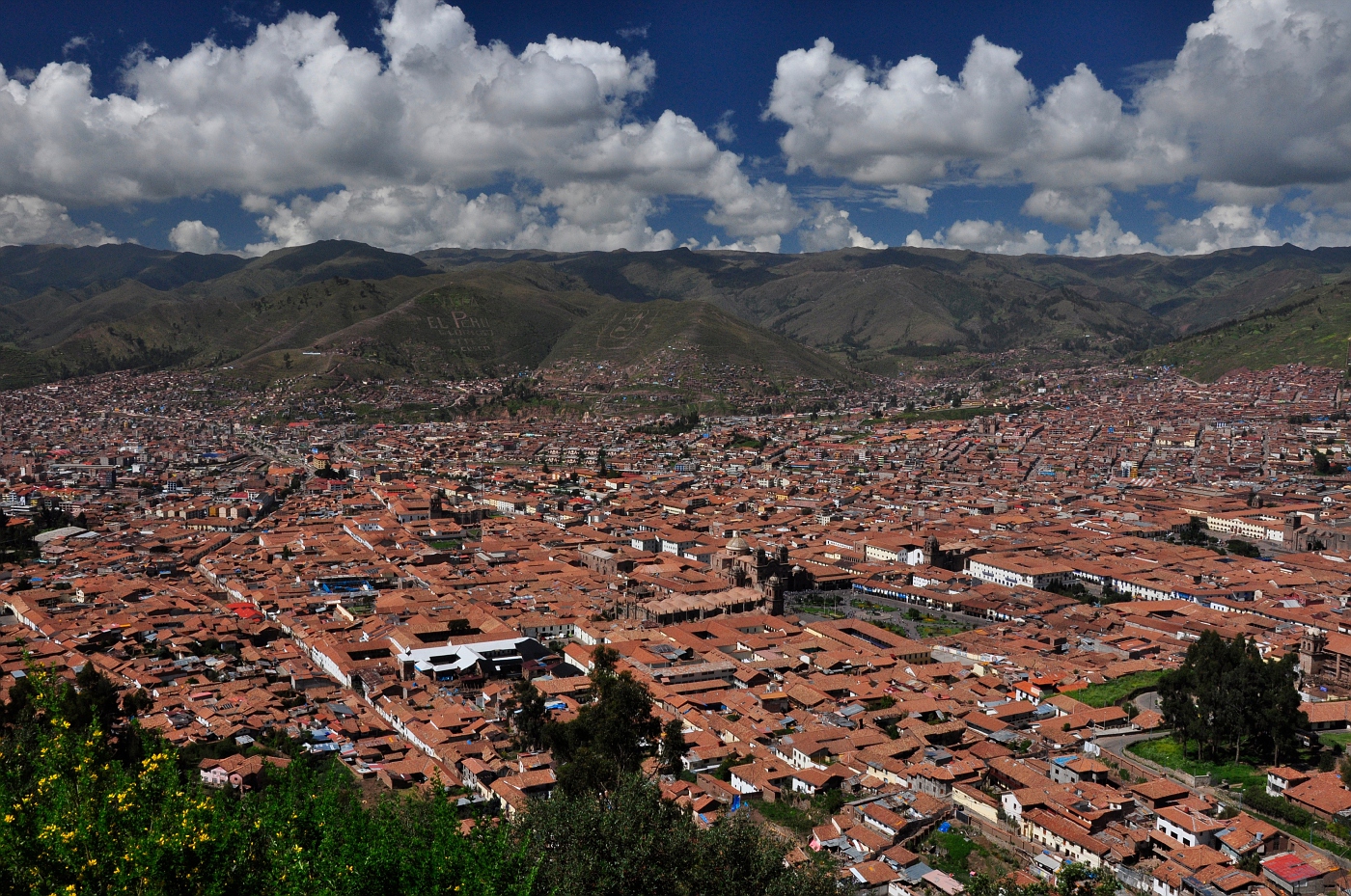 Every so often someone will ask me “How do you decide where to travel to?” Little do they know I have a very long list of destinations! Even though we have been to a ton of places, there are still a ton more to see. I got the idea for this trip after our dive trip last summer to the Galapagos. It never occurred to me that Machu Picchu in Peru was so close and then what better time to go to Easter Island since we would be near the west coast of Chile! So off we went. The only downsize to where we travel to is how long it takes to get there. It is not a hop, skip and a jump like to Mexico. No, we’re lucky if we make it to our destination in 24 hours! Every so often someone will ask me “How do you decide where to travel to?” Little do they know I have a very long list of destinations! Even though we have been to a ton of places, there are still a ton more to see. I got the idea for this trip after our dive trip last summer to the Galapagos. It never occurred to me that Machu Picchu in Peru was so close and then what better time to go to Easter Island since we would be near the west coast of Chile! So off we went. The only downsize to where we travel to is how long it takes to get there. It is not a hop, skip and a jump like to Mexico. No, we’re lucky if we make it to our destination in 24 hours!This trip almost didn’t happen though. Beginning of January, the Cusco/Machu Picchu (MP) region got an enormous amount of rain which washed out part of the Inca Trail and the rail line between MP and Ollantaytambo. Thousands of tourists were stranded and had to be air lifted out of MP. The trail was closed for the next three months while repairs were made. I had made reservations back in December and crossed my fingers the trail would be open again April 12 which was when we were to go. The trail opened no problem on April 1, but then there was the issue of getting a train ticket. Since only one train was running instead of the normal four, tickets were very hard to come by and our trekking company had to buy ours on the gray market. Normally worrying about if we had a train ticket or not would not be an issue but at the checkpoint before we began the trek, we had to show a government official we had a train ticket otherwise we were not allowed to go. But we got our tickets and were good to go!  Our trekking company required everyone to be in Cusco at least two days before departure to acclimate to the altitude, which is at 11,000 feet! I think living a mile above sea level helped us but we still felt it walking up the steep streets. I couldn’t help but feel sorry for the people who came straight from sea level. Our original plan upon arriving at 7am was to go straight to bed but that is really hard to do in a foreign city when there is so much to see. So we headed out to see the town and nearby Inca sights, oh, and a really big white Jesus statue that had creepy eyes! During our roaming of Cusco we came across the local market that had everything from dozens of juice and local food stalls, to ladies selling flowers, huge round loaves of bread, raw meat and what we think were cow noses. Hmm… I wonder if a cow nose makes a good soup stock? We did discover another thing in Cusco: Alpaca meat is goooood! Cured Alpaca meat on a pizza was especially good! Our trekking company required everyone to be in Cusco at least two days before departure to acclimate to the altitude, which is at 11,000 feet! I think living a mile above sea level helped us but we still felt it walking up the steep streets. I couldn’t help but feel sorry for the people who came straight from sea level. Our original plan upon arriving at 7am was to go straight to bed but that is really hard to do in a foreign city when there is so much to see. So we headed out to see the town and nearby Inca sights, oh, and a really big white Jesus statue that had creepy eyes! During our roaming of Cusco we came across the local market that had everything from dozens of juice and local food stalls, to ladies selling flowers, huge round loaves of bread, raw meat and what we think were cow noses. Hmm… I wonder if a cow nose makes a good soup stock? We did discover another thing in Cusco: Alpaca meat is goooood! Cured Alpaca meat on a pizza was especially good!A friend who recently went to Cusco told me that a festival happens every Sunday in the main square. We asked our B&B owner, Phillippe, if he knew what festival was going on that day and he says “There is not a festival today. Unless it is a holiday, but today there is nothing.” Remember that quote. So we head to the main square and guess what we came upon? Not a festival but a small parade. It was actually quite lame. It started out with school children in their uniforms marching (or trying to march) to the band. Then next came the business women of Cusco. They all had on business suits, heels and even carried their purses (I thought the purses was a nice touch!) 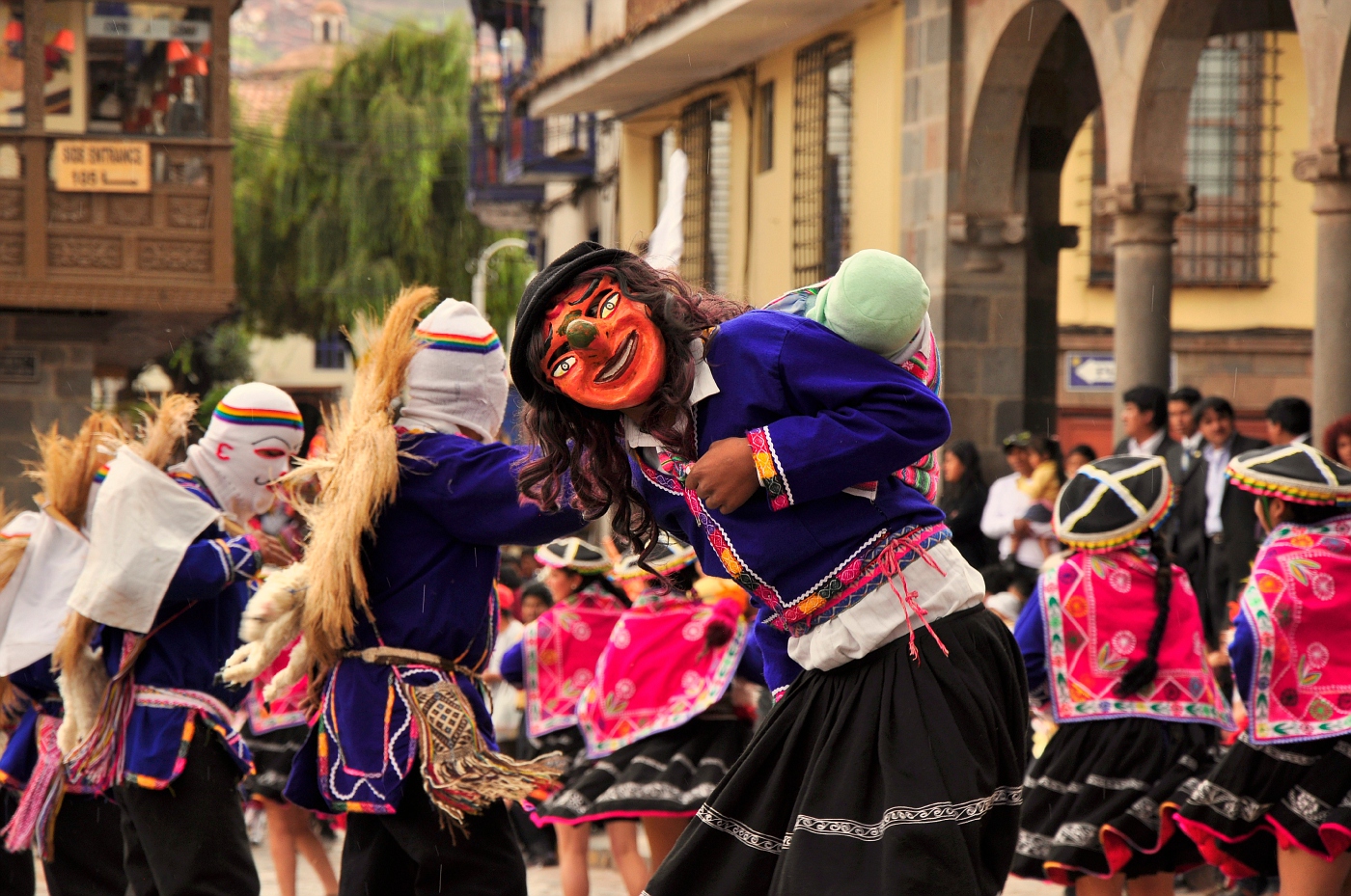 After watching this for 20 minutes we got bored and thought that Phillippe was right, this was no festival. Shortly after settling down at a nearby café to sample Peru’s famous coffee, we realized that yes, today there would be a festival. Starting from the opposite direction came groups of people in brilliant colored costumes and masks with trumpets, tubas, drums and dancing! Now this was a festival! And it went on for hours! It was a parade I would love to be in. At each corner the parade stopped and a kid would run out to the participants with a crate full of beer and pass them around. After watching this for 20 minutes we got bored and thought that Phillippe was right, this was no festival. Shortly after settling down at a nearby café to sample Peru’s famous coffee, we realized that yes, today there would be a festival. Starting from the opposite direction came groups of people in brilliant colored costumes and masks with trumpets, tubas, drums and dancing! Now this was a festival! And it went on for hours! It was a parade I would love to be in. At each corner the parade stopped and a kid would run out to the participants with a crate full of beer and pass them around.Each group was introduced by a banner that said who they were, but only one group was advertising a product… diapers and toilet paper. The group started out with a large roll of toilet paper dancing down the street then followed by small children (like 4 years old) dressed as cowboys wearing masks with large noses. I’m not sure which part was weirder: the part where they had bags of diapers shoved into their pants or that they were dancing holding bottles of beer! Then these kids were followed by adults dressed the same way, diapers and all stuffed into their pants. The only difference with the adults is that they were drinking the beer they were holding.  Personally if I had to go in public with diapers shoved in my pants, I would be drinking too. We tried to find out what the festival was for and after much questioning we found out it was the anniversary for the black market. What??? After we got back to our B&B we told Phillippe about the festival and he says (remember his quote from earlier?) “Oh yes, every Sunday there is a festival in the square." Personally if I had to go in public with diapers shoved in my pants, I would be drinking too. We tried to find out what the festival was for and after much questioning we found out it was the anniversary for the black market. What??? After we got back to our B&B we told Phillippe about the festival and he says (remember his quote from earlier?) “Oh yes, every Sunday there is a festival in the square."Of course, going to Machu Picchu by train like everybody else just isn’t our style so we decided to do the four day trek along the Inca Trail which is about 25 miles. Even though we normally do 8-10 miles hikes throughout the summer here in Colorado we were a bit nervous about the trek since we have never done a multi-day trip carrying our own gear. Luckily since this was our first time we had it quite easy because we didn’t have to carry our food or tents, just our own personal items. We have some friends that are true mountaineers that are reading this and probably laughing their asses off thinking how easy we had it! I’ll admit, it could have been much tougher then it was, although it was still tough. 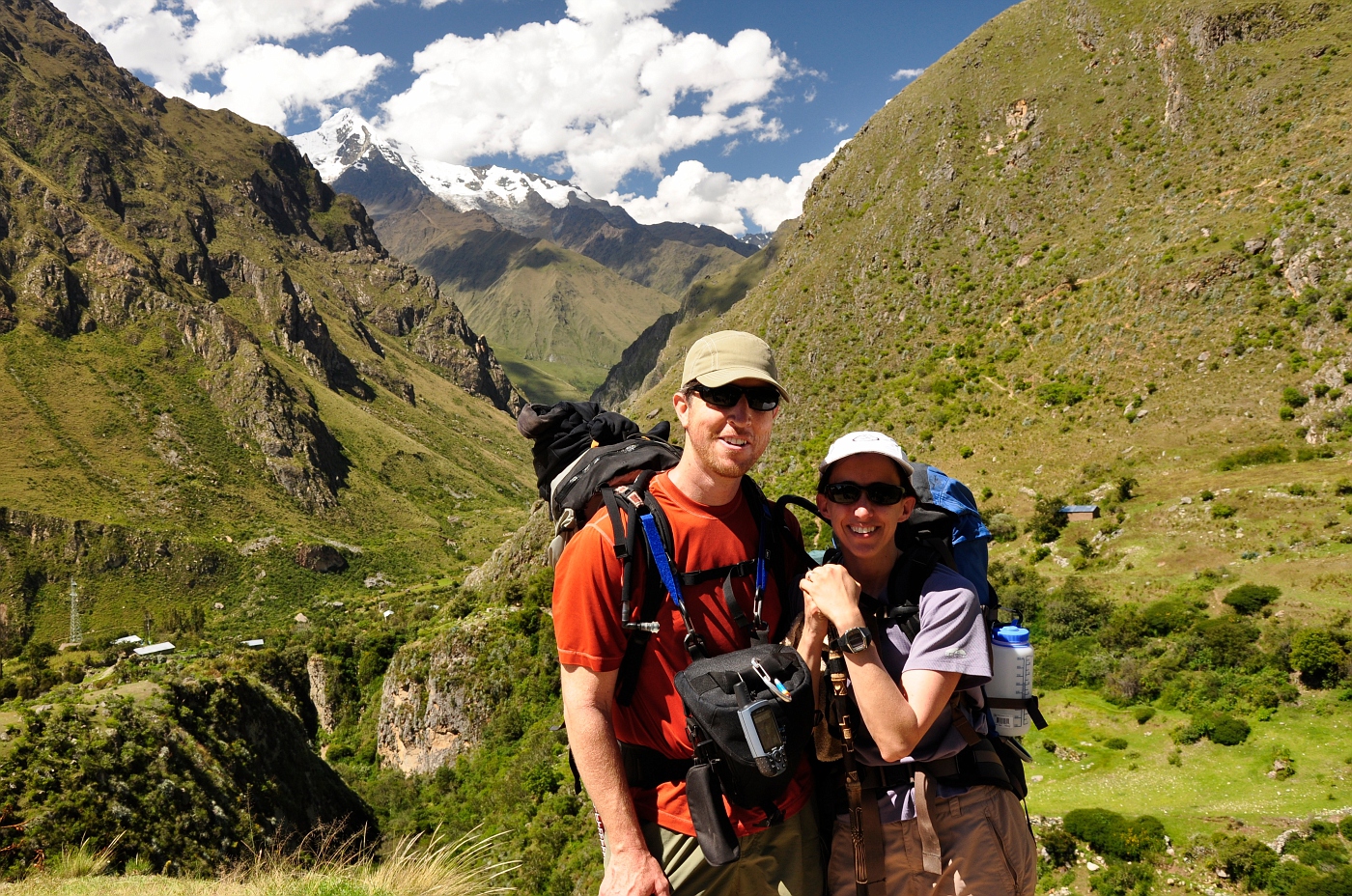 Our group was made up of people from all around the world: Germany, China, Australia, New Zealand, Canada and the US. The first day everyone in our group seemed to be sizing each other up: My pack is bigger than yours. I wonder if I could have brought a smaller pack? You’ve climbed Mt. Kilimanjaro? Are you going to be slow or fast? Does your ten year old daughter even want to do this? You have never heard of zip-off pants? But soon everyone fell into a groove with each other even though no one could remember the others name. Our group was made up of people from all around the world: Germany, China, Australia, New Zealand, Canada and the US. The first day everyone in our group seemed to be sizing each other up: My pack is bigger than yours. I wonder if I could have brought a smaller pack? You’ve climbed Mt. Kilimanjaro? Are you going to be slow or fast? Does your ten year old daughter even want to do this? You have never heard of zip-off pants? But soon everyone fell into a groove with each other even though no one could remember the others name.You know how in a group there is always that one annoying person? Well ours was Chuck Norris. His real name was Eric, but one of the porters named him Chuck Norris because of his hair and the name stuck. Sometime not too long ago I think he fried part of his brain on drugs because something about him just wasn’t right. He really was an idiot. He kind of made life miserable for everyone in the group, especially the guide. He would be anywhere from 20 minutes to 2 hours behind everyone else and would get pissed that the guide didn’t wait for him although there was a guide who was always behind him bringing up the rear. 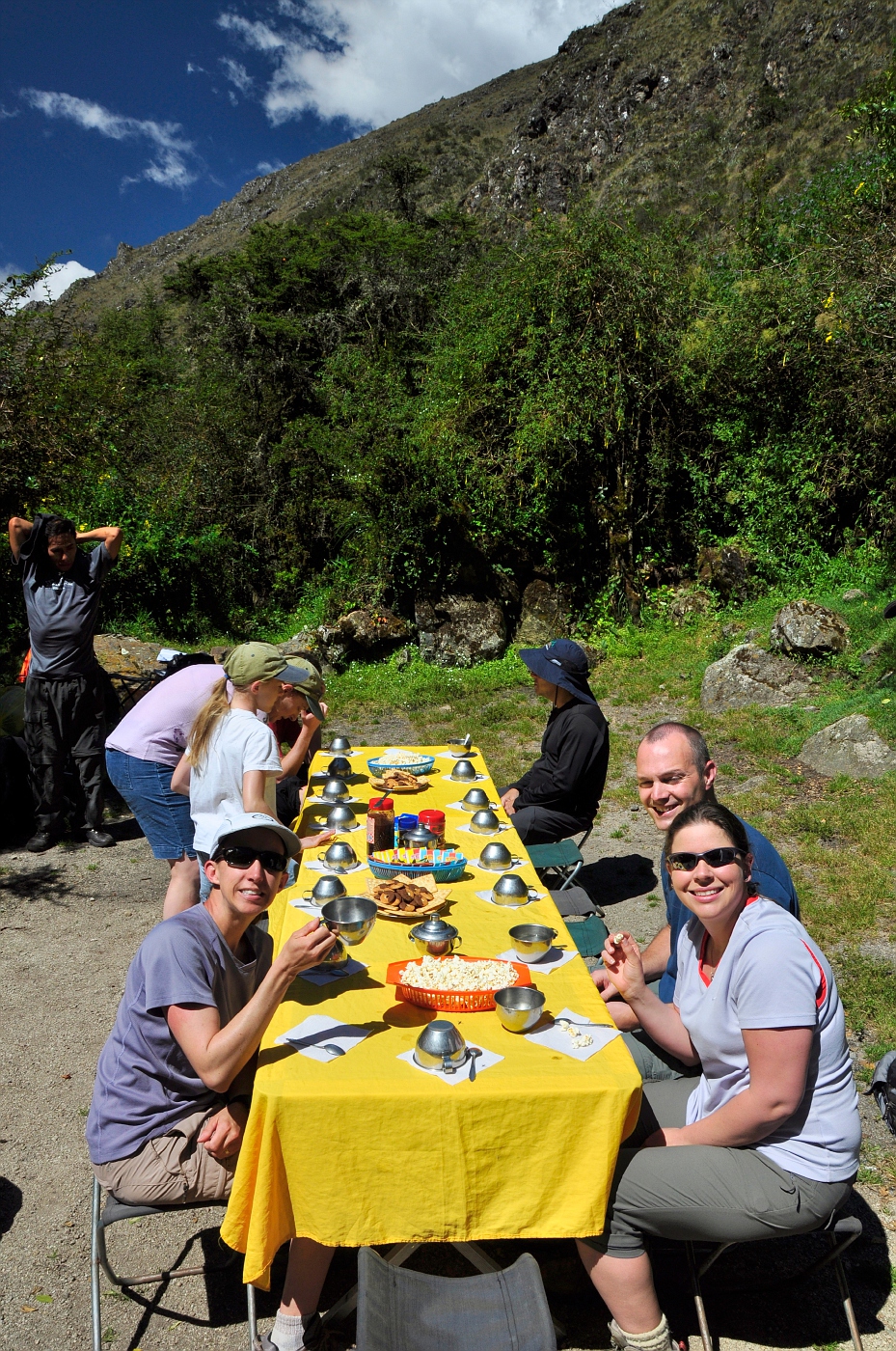 There are a lot of trekking companies out there and we were very happy with our company, Peru Treks. Upon arrival at each stop for a meal we were greeted with juice, bowls of warm water and soap were laid out for us to wash up before eating, at the campsite our tents were set up and taken down for us by the porters and each morning coffee was brought to our tent. Oh, and the food was awesome. Speaking of the porters, they are who made the trip possible. Each trekking group had their own porters who carried the sleeping tents, food tent, collapsible stools, food, propane, eating utensils, tea kettle and whatever else was needed to make our stay comfortable. They did the same trek with us but at a much faster pace and with more weight on their backs. The government regulates it so that each porter cannot carry more than 55lbs. That is still a lot of weight but before the government got involved, each porter carried over 100lbs. One of our porters was even 66 years old! So we never once complained about the weight of our own packs. There are a lot of trekking companies out there and we were very happy with our company, Peru Treks. Upon arrival at each stop for a meal we were greeted with juice, bowls of warm water and soap were laid out for us to wash up before eating, at the campsite our tents were set up and taken down for us by the porters and each morning coffee was brought to our tent. Oh, and the food was awesome. Speaking of the porters, they are who made the trip possible. Each trekking group had their own porters who carried the sleeping tents, food tent, collapsible stools, food, propane, eating utensils, tea kettle and whatever else was needed to make our stay comfortable. They did the same trek with us but at a much faster pace and with more weight on their backs. The government regulates it so that each porter cannot carry more than 55lbs. That is still a lot of weight but before the government got involved, each porter carried over 100lbs. One of our porters was even 66 years old! So we never once complained about the weight of our own packs.Our first day was easy with most of the trek flat going through grass fields and passing the occasional small Inca sight. The second day was a different story, but more on that later. The first camp site was gorgeous with views of the beautiful Andes mountains surrounding us and a zillion stars after the sun set. The only bad thing about our site was the toilet. Oh, the toilet. Obviously there is no running water here, so it is a squatter toilet (toilet level with the floor) in an outhouse with a trash can in the corner for the toilet paper. We quickly found out that there were people along the trek that were having problems with their bowels and not quite making it to the toilet in time. This was evident in the outhouse because there were piles of shit on the floor that missed the toilet by 6”. And yes, this is gross, very gross, but it was a part of our everyday life on the trek!  The second day was the challenge: it was straight up from the camp and gained over 4200’ in elevation in a little over 5 miles. The pass was called Dead Woman’s Pass and Cesar, our guide, told us the story of how it got its name but it was so lame it doesn’t even deserve to be repeated - but Cesar is a great story teller. Right after breakfast Cesar gave us a demonstration on how to chew coca leaves to alleviate altitude sickness. This was quite the novelty because coca leaves is the raw form that cocaine is made of. After chewing several leaves and then spitting them out after two minutes, the tongue goes numb. The leaves made me gag and I had no desire to chew them while struggling up the steep climb so I did without. Fortunately Troy and I were fine whereas others in our group did not have such an easy time with the altitude, coca leaves or not. So backpacks on, here we go. Cesar said it would take five hours to reach the top. Troy and I did it in three! Guess all the training at the gym paid off! A lot of people in our group that day had problems whether it was dehydration, diarrhea, headaches, nausea, lost toe nails or just pure and simple struggled to get up the hill, I was happy Troy and I had no problems. Once we got to the top it was straight down to our next campsite. The second day was the challenge: it was straight up from the camp and gained over 4200’ in elevation in a little over 5 miles. The pass was called Dead Woman’s Pass and Cesar, our guide, told us the story of how it got its name but it was so lame it doesn’t even deserve to be repeated - but Cesar is a great story teller. Right after breakfast Cesar gave us a demonstration on how to chew coca leaves to alleviate altitude sickness. This was quite the novelty because coca leaves is the raw form that cocaine is made of. After chewing several leaves and then spitting them out after two minutes, the tongue goes numb. The leaves made me gag and I had no desire to chew them while struggling up the steep climb so I did without. Fortunately Troy and I were fine whereas others in our group did not have such an easy time with the altitude, coca leaves or not. So backpacks on, here we go. Cesar said it would take five hours to reach the top. Troy and I did it in three! Guess all the training at the gym paid off! A lot of people in our group that day had problems whether it was dehydration, diarrhea, headaches, nausea, lost toe nails or just pure and simple struggled to get up the hill, I was happy Troy and I had no problems. Once we got to the top it was straight down to our next campsite.The third day was the longest day. The distance covered was longer and there were more Inca sights to stop and see so it took everyone 10 hours to get to camp. That is, except for Chuck Norris and his girlfriend. They were two hours behind everyone and arrived at camp after dark. Before we arrived at our last camp everyone had to walk down Gringo Killer which was 3000’of elevation loss in the form of steps that went down, down, down. If no one was sore before this, they were sore after wards. The last camp was a very civilized with showers and a bar and restaurant. After throwing our packs in our tent and taking a quick shower we all headed to the bar. Funny thing, we drank all their beer!  There were probably 30 other people in the bar before us but when a girl from our group went to buy us five beers, she was cut off. We all thought five was the limit that could be bought at one time. Ended up five was the limit because that was all that was left. But what do you know, 30 minutes later here comes a porter with a potato sack full of beer! There were probably 30 other people in the bar before us but when a girl from our group went to buy us five beers, she was cut off. We all thought five was the limit that could be bought at one time. Ended up five was the limit because that was all that was left. But what do you know, 30 minutes later here comes a porter with a potato sack full of beer!Our last morning we rose at 3:45am had a quick breakfast and were on the trail by 4:45. It had rained very heavily the night before but stopped by the time we got up. We have had such gorgeous weather to this point that a little rain was to be expected. There is a gated checkpoint on the Inca Trail that leads towards MP. It didn’t open until 5:30 so all the trekkers were lined up at this gate when it opened. Then it became kind of a mad dash to MP. Cesar kept warning us that there would be trekkers who would over take each other and to just let them but to stay on the mountainside. There is a very steep drop off the edge that would make the beginning of any ones day very bad! Our first meeting point as a group was at the Sun Gate. This was an Inca site that was at the top of a pass. I think we left our campsite so early so that when we got to the Sun Gate we could see the sunrise over MP.  But unfortunately because of the previously nights rain, everything was shrouded in clouds and there was to be no sunrise over MP. Once everyone realized this, there was no longer a mad dash to get to MP first. So along we kept trekking, having no idea whatsoever that just beyond the clouds was MP! The first inclination I had that we were really close was when out of the clouds came this woman wearing a pink and white flowered sundress! I almost stopped in my tracks and looked around and thought “Where the hell did she come from?!?” But then more and more of these oddly dressed people who were clean and smelled good started appearing out of nowhere. But unfortunately because of the previously nights rain, everything was shrouded in clouds and there was to be no sunrise over MP. Once everyone realized this, there was no longer a mad dash to get to MP first. So along we kept trekking, having no idea whatsoever that just beyond the clouds was MP! The first inclination I had that we were really close was when out of the clouds came this woman wearing a pink and white flowered sundress! I almost stopped in my tracks and looked around and thought “Where the hell did she come from?!?” But then more and more of these oddly dressed people who were clean and smelled good started appearing out of nowhere.We finally arrived at MP and was a little disappointed because of the cloud cover. But slowly as the sun warmed up the air, bits and pieces of MP started revealing itself to us until finally the entire cloud cover burned away and we could see MP in all its glory! If I was a religious person I would almost think I heard angels singing! But since I’m not I’ll say I heard Metallica rocking out as the clouds disappeared!  Along the trek we did learn a few things besides the fact that large packs of dogs love to bark and chase after chickens through our camp at 3 am. For instance the Inca trail was not used by the common person, it was used by important people such as architects, astronomers, priests and the occasional king and there was more than one trail to confuse the enemies. The Inca’s were master stone builders and never used mortar of any kind to build walls and that the stones were carved and sculpted so tightly next to each other that even a blade of a knife can’t be inserted. What struck me the most was how random the Inca dwellings were built in the mountainside and how they were in the middle of nowhere, miles and miles from anything. Along the trek we did learn a few things besides the fact that large packs of dogs love to bark and chase after chickens through our camp at 3 am. For instance the Inca trail was not used by the common person, it was used by important people such as architects, astronomers, priests and the occasional king and there was more than one trail to confuse the enemies. The Inca’s were master stone builders and never used mortar of any kind to build walls and that the stones were carved and sculpted so tightly next to each other that even a blade of a knife can’t be inserted. What struck me the most was how random the Inca dwellings were built in the mountainside and how they were in the middle of nowhere, miles and miles from anything.Because of all the photos I have seen of MP, I knew what to expect when we arrived, or at least what to expect after the clouds lifted. But after seeing it in person after the 4 day trek, it impressed me far more than I expected. Along the trek all the Inca sights were small, with maybe a few terraces for farming but MP is huge and is truly a Lost City. It was only recently discovered in 1911 and covers about 5 square miles and even though little is known about the social or religious use it is believed that it’s primary function was for astronomical observation. This was an extraordinary journey and every single one of us in our group felt that we deserved to be there and not the people who came in by train! They should at least be required to do some jumping jacks or push ups before they get to go! Next up, Easter Island! |

